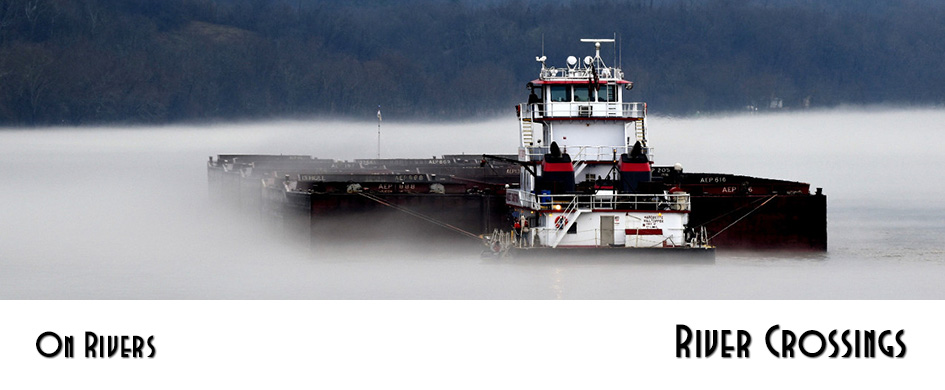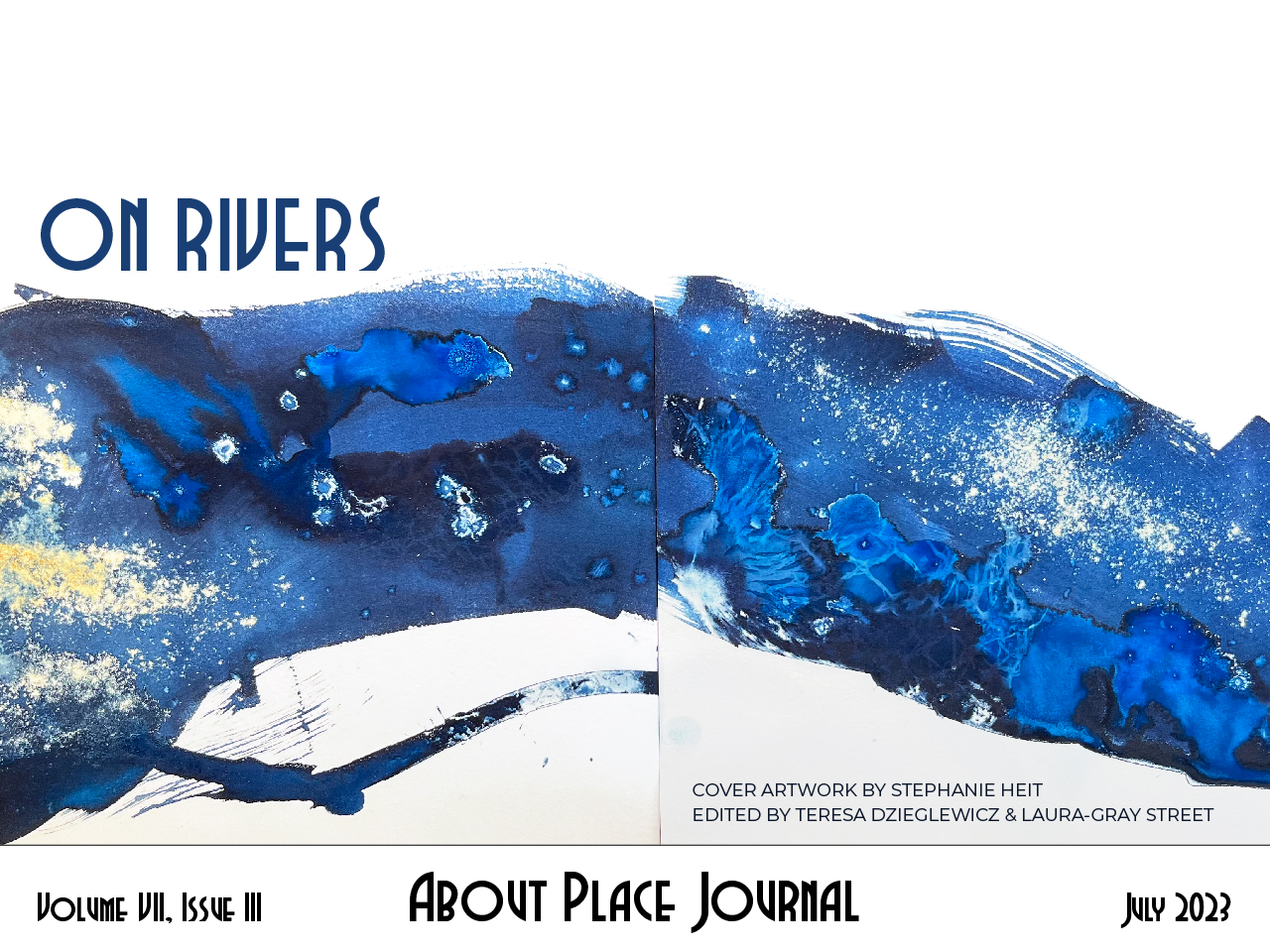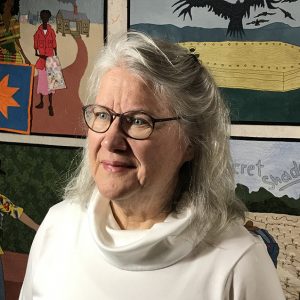 Master quilter Cathy Fussell is known nationally for her map quilts, as well as being the creator of the Michelle Obama quilt “Apollo Splashdown Revisited – Homage to Alma Woodsey Thomas.” She has been a quilter for 50 years. Her work can be found in public museums and private collections. She is a retired English professor. She currently lives in Columbus, Georgia.
Master quilter Cathy Fussell is known nationally for her map quilts, as well as being the creator of the Michelle Obama quilt “Apollo Splashdown Revisited – Homage to Alma Woodsey Thomas.” She has been a quilter for 50 years. Her work can be found in public museums and private collections. She is a retired English professor. She currently lives in Columbus, Georgia.
Jaqueline: Can you talk about your journey as a quilter?
Cathy: I come from a long line of women who sewed. My mother was a great seamstress, and so were my grandmother and my aunts, and the women in my town too. But most of the women in my family, if not all of them, certainly sewed. The day I was born my mother got a sewing machine, as a gift from my father. So, I think that said something. That’s one of those little Singer Featherweights. I still have that machine. My mother took great pride and pleasure in her sewing. She made clothes for all of us. I’m the oldest of six kids. So, she made clothes for us, and she made costumes. I just watched her enjoy it. I watched her take pride in it, and I picked it up.
The attraction for me was my maternal grandmother. We lived in Georgia, where my dad’s folks are from, but my maternal grandmother and an aunt lived in North Louisiana. We would go out there once or twice a year. She was just an all-around great person and country woman. She was a great storyteller, a great cook, great seamstress, and great gardener.
Every time we went to visit, she would have a new method for sewing or some new trick up her sleeve she would have learned from the home demonstration agent, or from the little, rural women’s club. It would be some new sewing method she would teach us. One time it would be hooking rugs, and one time it would be making little dolls out of the milk strainers. There was a different new something she would learn in terms of textiles that she would show us. We’d sit on the front porch with the other misses and granddaughters, and we would practice that new trick, whatever it was, and I just really looked forward to that. When I was in high school, I made some of my clothes. I didn’t have much time on the sewing machine because mama was on the sewing machine all the time. When I was in college, I would come on the weekends and sew. When I was 19, I started to quilt.
And my first job out of college was at a living history village down in South Georgia, where I was hired to be the spinner and weaver and there were other women there who quilted. But that really kinda amped up my textile game all the way around, and I just haven’t stopped.
I had other jobs, and then I had a 28-year teaching career. And when I retired in 2011, I just really went all out. All that time I was quilting, I quilted when I could grab a moment, but there weren’t many moments to grab, as you know, when you teach and raise a family. But after I retired, I just hit the ground running with quilting, and went about it full time every day. That was eleven years ago. I’ve had a few strokes of good luck and received some attention that I did not expect. I did not anticipate having a second career at all, but I have one. I love it, and it’s quilting. I mean, it’s happening.
Jacqueline: Can you talk about what brought you to the first Lady Michelle Obama/Alma Thomas quilt?
Cathy: It was made at the request of the Congressional Club which used to be the Congressional Wives Club, but they changed the name a few years ago, because now we have women in Congress, and so there are men who are spouses of members of Congress. But once a year the Congressional Club hosts a luncheon to honor the first lady, whoever the first lady is. It’s a big social deal. About 2,000 women dressed in their finest go to this luncheon in the Hilton ballroom in Washington.
Every year a different state is responsible for organizing the first lady’s luncheon, and in 2016, it was Georgia’s turn. Sanford Bishop has been our Representative forever and ever. We know Representative Bishop and his wife, Vivian Creighton Bishop. She oversaw the First Lady’s luncheon, and she engaged a good friend of mine, a woman by the name of Florene Dawkins, to help her organize this luncheon. Florene knew several things. One of them was that Michelle Obama loves the work of Alma Thomas.
Alma Thomas was born and grew up, until she was 14, just about 2 blocks from where I am sitting right now. She was born in the 1890s and died in the 1980s. She is now a renowned painter in the Abstract school, and the Washington Colorist group.
Florene, my friend, also knew that I quilted, and that my family had followed Alma Thomas’ work for decades. My husband had worked at the museum here in Columbus, and he had helped to mount a huge show of Alma Thomas’ work 30 years ago. We met her surviving great nephew. We’re still friends with her nephew, and so Florene knew that.
Florene is the one who came up with the idea that maybe I could make an Alma Thomas inspired quilt for the Congressional Club to give to Michelle Obama as a gift from Georgia. So, she posed that idea to Vivian Creighton Bishop. Oh, man, I just about fainted when they invited me to do the quilt. I was so honored.
They gave me little more than a year, and they gave complete freedom so long as the piece was inspired by Alma Thomas. I also had complete freedom as to the size, material and which Alma Thomas piece to reference. I couldn’t ask for anything more and my thinking was, I’ll make one and see how they like it, and if they don’t like it, I’ll have time to make another, and maybe another.
Well, I spent about two weeks really digging into Alma Thomas’ work. I was already familiar with it, but I wanted to really look at it again. So, I got out all the Thomas books and read and read. I spent about two weeks experimenting with fabric. I wanted to replicate her brush strokes, and that is not as easy as it sounds when you’re not using paint. To replicate certain features in fabric is challenging. So, I tried a number of different methods and didn’t like them, and then finally I landed on a method that I liked. I worked hours and hours every day for about a month. I finished the quilt, and I liked it. Vivian took it to Washington, and we got to go meet Michelle Obama, and it was great.
Jacqueline: Oh, I love that story. I mean, it is really an intimate story that comes out of your life. It brings out your whole history, and a completely different storyline in terms of connection and deep community.
Cathy: Florene Dawkins is a close friend of mine and has always been. She’s from Little Rock, but she’s lived in Columbus, Ga. for 40 years, and she’s really on top of everything art wise that’s happening around here. Particularly African American art. Florene was the key to the whole thing. She’s the reason that I got that opportunity. You know, I seriously appreciate her for that.
Jacqueline: You have a map quilt series. How did you get started?
Cathy: About the time I retired I started thinking about making a trip over to Gee’s Bend, Alabama. I had been looking at the Gee’s Bend quilts for a long time and was so thrilled with the attention they were getting. And you know that the Gee’s Bend quilts have changed, not just the quilt world, but I think they’ve changed a lot of attitudes about the larger art world.
Jacqueline: Definitely. I had the privilege of walking behind them as they entered the Whitney Museum to talk about their quilts.
Cathy: Oh, my goodness. I’ve met Louisiana Bendolph and Mary Ann Pettway. Louisiana Bendolph speaks like a poet. Anyway, I was just here in my house thinking I’d like to go over to Gee’s Bend and just see what it looks like over there.
I got out my computer and googled Gee’s Bend to see how long it would take me to get over there, because it is not that far. I mean Montgomery’s an hour and a half from here. So, I thought you know I could drive over there easily. I went to the computer and looked. And I just was struck by this map that I saw of that dramatic curve in the river. I mean, just this incredibly dramatic curve in the river. I put the computer down and went into my studio. I printed it out on an 8 1/2 by 11 sheet of paper, and I thought the river has to be done in denim. I pulled out this big piece of denim. And then Fred, my husband, who is a painter, had this canvas that he wasn’t using. And I put it on the table and started drawing.

I drew the Alabama River at Gee’s Bend, which today, I think, is probably my best map quilt. It was the first one I made. Technically, it had issues, you know. I think if the “quilt police” looked at it they’d bust me from here to Selma and back. But it works, you know. It’s on exhibit now, at the Southeastern Quilt and Textile Museum, and I’m missing it because it usually hangs in our living room.
As soon as I made that one, I knew that I wasn’t finished making map quilts. I started making map quilts. I probably couldn’t count how many. A lot of them are pillows. I’ve made a lot of pillows that show rivers and creeks and the river systems of each state and of some foreign countries. Now, I’m getting away from making pillows. It is a lot of work for the money.
The Alabama River at Gee’s Bend is exactly what got me started. I talk about that quilt as being an homage to the Gee’s Bend quilters. I didn’t want to try to copy their work as a lot of people have done. But I’m happy that I did something to honor them.
Jacqueline: What a great story. Is there anything else about the river as a form that intrigues you or that continues to attract you?
Cathy: What inspires me with the rivers are two things: one is, I like the curve. Just the look of it. When I just go on Google and look at a river and see a place that has a big oxbow or a big old curve, or bigger double curve, that’s what I wanna do. The other thing is that people commission me. I don’t ever change the course of the river, but I very carefully choose the specific area I want to include, so that the final piece, the quilt, exhibits good composition. I do my own work about half the time. I’d say commission work may be a little less than half the time.
I think one of the people on Zoom the other day asked if my thinking about rivers had changed since I’ve been doing this work? What has happened is, I’ve noticed I pay a lot more attention to rivers when we’re traveling. I’m aware of when we’re approaching a river. And I really look around to see where the floodplains are. And I really look to see if we’re in rocky territory, and how wide the river is, and what color it is, and what creeks are feeding into the river. Whether it’s rocky shoals or looks like a deep river. I’m much more conscious of rivers as we travel across rivers in the real world.
I pay attention to the print media and what’s happening with rivers. You know, efforts to clean this up or clean that up. I’m interested in rare plants and endangered plants. So, I pay attention to what’s being done.
I’ve also hooked up with so many river people. I give one quilt a year to one of the river causes.
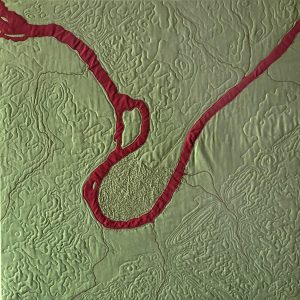
Jacqueline: Do you have any favorite river quilts?
Cathy: Well, the Gee’s Bend is among my favorites. And people really respond to it. They don’t even know it’s Gees Bend at first, but they respond to just the image. It looks like a dragon, so it’s a visually powerful piece. I won’t say it’s my favorite river quilt I’ve ever done. I have a couple of others that I love like “Genocide at Horseshoe Bend.”
Jacqueline: Do you want to talk about some of the other types of quilts you make?
Cathy: Yes, but before we leave the river quilts, let me say that river quilts often involve the topographical contour lines. I use the topographical contour lines from Geological Survey maps if the scale allows me to.
Sometimes I’ll do a piece that’s just the topographical contour lines without the river. One of the most beautiful pieces I’ve made was of a spot in Taylor County, Georgia, about 30 miles from where I’m sitting. There’s not a river in there, and it’s the topographical contour lines which make these crazy, weird shapes. Sometimes the topographical contour lines of parts of North Alabama looks like blooming flowers. They are map quilts, but they’re not rivers.
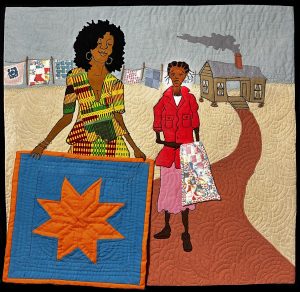
In addition to the map quilts, my husband and I have been collaborating for the past couple of years on a series we call Southern Lit 101. For that we’ve made about 12 or 13 pieces, inspired by the great Southern writers William Faulkner, Flannery O’Connor, Alice Walker, Harper Lee, Carson McCullers. Am I leaving somebody out? And, oh, yes, from the oral tradition a Muskogee Creek folktale.
I don’t draw well at all. But Fred does. We collaborate on content. We have a collaborative process that we have been going about in a structured way. He draws the scenes we have chosen, and then I cut out the pieces and put the colored fabric down and sew it up. Lastly, I quilt the piece. Our Southern Lit 101 series has just gone on exhibit at Southside Gallery, on the Square in Oxford, Mississippi. We were there last week for the opening event and the artist talks as part of the Oxford Conference for the Book. It was very well attended with standing room only. It was great.
Besides the map quilts and the Southern Lit 101 quilts, I make abstract pieces. I really love my abstract pieces which I am starting to create. I’m beginning to have a series I’m calling Particle quilts. Some of them are inspired by microscopic images and some are inspired by outer space. I just made a big one of a black hole. I’m interested in particles whether they’re little, tiny particles that you can see only with the microscope or the big, huge particles out in space, such as planets. In the particle quilts, I came up with a method for attaching small pieces to a quilt and keeping them there with netting, and isolated from each other. It’s hard to explain. But I came up with this method that is really working for me.
Jacqueline: You not only have a new subject matter, but you also have new techniques. Do you find that happens as you’re working on different subjects or themes?
Cathy: Absolutely. There are a lot of quilters, particularly art quilters who do a lot with experimenting on the fabric surface. I like to get good at something and stick with it for a long time. I have been led through my work to occasional new techniques.
Jacqueline: Your daughter is also a quilter. In what ways is your work, if at all, in conversation with her work or not?
Cathy: Well, our work is vastly different from each other. And we came to quilting from totally opposite directions. But we do talk a lot about quilts and quilting, and not specifically our own work necessarily. We don’t talk about each other’s technique very much, you know.
Coulter was never very interested in sewing when she was growing up. The boys were more interested. She thought it was girly and she didn’t want to be too girly, so she just didn’t try to sew. But she was an art kid. She was always drawing and cutting out paper and painting. She went off to college and majored in art, and then was a painter.
One weekend she came home from college and said, “Mama, if I go into your fabric stash and cut out some pieces and throw them down in a design will you make a quilt?” I said, “Oh, yeah!” So that’s what we did.
She went into my stash and pulled out these pieces of fabric that I never, ever would have put into a quilt. I mean the corduroy, burlap, and sticky upholstery fabric. She pulled out all this crazy stuff and cut it into pieces. She made what is a narrative image of a folk song in our family, “Possum up a ‘simmon tree, Fox down on the ground.” I sewed it up, and it’s a great quilt, and then we turned around and made two more. She still had not sewed a stitch at this time, but we had made three great quilts that have been exhibited a lot of places, and I wish we had done more.
She got married and had kids, and she lives in Mississippi, and we just didn’t have a lot of opportunities to work together. We talk about quilting, but she went in her direction, and I went in my direction. I started from a dress makers perspective. I was brought up to be really focused on precision.
I was taught how to make French seams and flat-felled seams and bound buttonholes and gussets and all those dressmaking techniques. I’ve had to work hard to be freer in my work – to get away from precision and be more expressive. To not be bound by the confines of precision. I’ve worked hard at that, and Coulter, who comes at quilting from the perspective of an artist, a painter, has really helped me do that.
And she’s been opposite. She started out with no sewing skill, I mean no sewing skill, and she has pretty much taught herself. So we’ve come at quilt-making from totally different beginnings, and we’re still far away in some respects, except that we’re both making water quilts. She has a big exhibit of river raft quilts opening soon, and the curator has asked me to put one of mine in there. We had a two person show in Athens not too long ago of her river raft quilts and my river quilts. I mean, if you looked at mine and then looked at hers, you would not know they had the same DNA. And she’s ever evolving, you know. Her work is becoming more sculptural. It’s coming off the wall. She’s doing textile sculpture now.
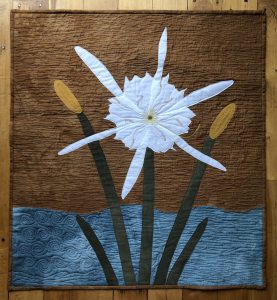
Jacqueline: Oh, wow! Do you want to talk a bit about tools of the trade?
Cathy: I like simplicity in my studio. I’m not one to buy a bunch of the latest gadgets. Over the years, I have acquired some tools that work for me, but I have a simple, straight stitch machine. I don’t have a long arm, you know. I don’t accumulate a lot of fancy stuff. I like to keep things simple. I like my studio to be sort of portable. My tables are folding tables. They’re not permanent. My furniture in here is not built in. I have to move it around with the various projects that I work on. Sometimes I need a big flat space, and sometimes I need something else.
Jacqueline: What would be your suggestion to someone who was just starting out in quilting?
Cathy: Do not be held back by the fear of messing up. Just go for it. Don’t let a focus on precision hold you back. Now those women who make the precision quilts. I admire the heck out of them. I used to be one. I love their work. It’s beautiful. But with a lot of beginning quilters, particularly if you go to a class that teaches very traditional strict precision pattern quilting, a lot of people are discouraged from the get-go because they can’t achieve precision at first, and they feel as if they’re getting their hands slapped when they’re making a mistake. My advice to new quilters is to jump in with a more improvisational approach, and then, if you want to go and learn precision techniques, you can. But if you try to start off focusing on precision, you might lose interest quickly and become discouraged to the point that they give up quilting entirely. If you are somebody who’s starting out now, I would look for a teacher who teaches improvisational quilting.
Upcoming Exhibitions:
Two-person exhibit, with Marian Zielinski, at Southeastern Quilt and Textile Museum, Carrollton, Georgia, April – June, 2023.
Exhibit with Fred Fussell (paintings) and Henry Jacobs (photographs) at Cochran Gallery, LaGrange, Georgia, July – August 2023.
Exhibit at Gumtree Museum, Tupelo, Mississippi – Fall 2023.
“Event Horizon” curated into “Too Much Is Just Right: The Legacy of Pattern and Decoration” at the Asheville Art Museum, Asheville, North Carolina, February 2 – May 29, 2023.
“The Myth of the Chattahoochee Tie Snake” curated into “Kudzu Soliloquy” at the Wiregrass Museum in Dothan, Alabama, April 21 – June 24, 2023.

